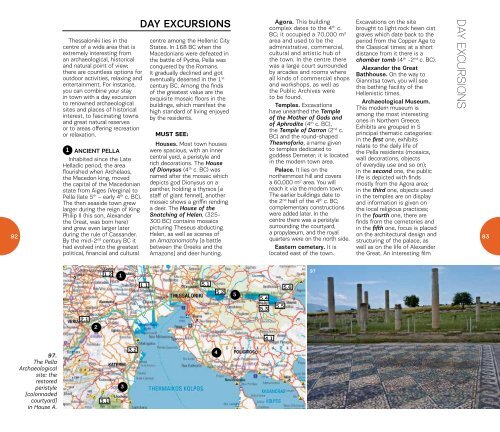Thessaloniki_EN
You also want an ePaper? Increase the reach of your titles
YUMPU automatically turns print PDFs into web optimized ePapers that Google loves.
82<br />
<strong>Thessaloniki</strong> lies in the<br />
centre of a wide area that is<br />
extremely interesting from<br />
an archaeological, historical<br />
and natural point of view;<br />
there are countless options for<br />
outdoor activities, relaxing and<br />
entertainment. For instance,<br />
you can combine your stay<br />
in town with a day excursion<br />
to renowned archaeological<br />
sites and places of historical<br />
interest, to fascinating towns<br />
and great natural reserves<br />
or to areas offering recreation<br />
or relaxation.<br />
1 ANCI<strong>EN</strong>T PELLA<br />
Inhabited since the Late<br />
Helladic period, the area<br />
flourished when Archelaos,<br />
the Macedon king, moved<br />
the capital of the Macedonian<br />
state from Aiges (Vergina) to<br />
Pella (late 5 th – early 4 th c. BC).<br />
The then seaside town grew<br />
larger during the reign of King<br />
Philip II (his son, Alexander<br />
the Great, was born here)<br />
and grew even larger later<br />
during the rule of Cassander.<br />
By the mid-2 nd century BC it<br />
had evolved into the greatest<br />
political, financial and cultural<br />
DAY EXCURSIONS<br />
centre among the Hellenic City<br />
States. In 168 BC when the<br />
Macedonians were defeated in<br />
the battle of Pydna, Pella was<br />
conquered by the Romans.<br />
It gradually declined and got<br />
eventually deserted in the 1 st<br />
century BC. Among the finds<br />
of the greatest value are the<br />
exquisite mosaic floors in the<br />
buildings, which manifest the<br />
high standard of living enjoyed<br />
by the residents.<br />
MUST SEE:<br />
Houses. Most town houses<br />
were spacious, with an inner<br />
central yard, a peristyle and<br />
rich decorations. The House<br />
of Dionysus (4 th c. BC) was<br />
named after the mosaic which<br />
depicts god Dionysus on a<br />
panther, holding a thyrsos [a<br />
staff of giant fennel], another<br />
mosaic shows a griffin rending<br />
a deer. The House of the<br />
Snatching of Helen, (325-<br />
300 BC) contains mosaics<br />
picturing Theseus abducting<br />
Helen, as well as scenes of<br />
an Amazonomachy [a battle<br />
between the Greeks and the<br />
Amazons] and deer hunting.<br />
Agora. This building<br />
complex dates to the 4 th c.<br />
BC; it occupied a 70,000 m 2<br />
area and used to be the<br />
administrative, commercial,<br />
cultural and artistic hub of<br />
the town. In the centre there<br />
was a large court surrounded<br />
by arcades and rooms where<br />
all kinds of commercial shops<br />
and workshops, as well as<br />
the Public Archives were<br />
to be found.<br />
Temples. Excavations<br />
have unearthed the Temple<br />
of the Mother of Gods and<br />
of Aphrodite (4 th c. BC),<br />
the Temple of Darron (2 nd c.<br />
BC) and the round-shaped<br />
Thesmoforio, a name given<br />
to temples dedicated to<br />
goddess Demeter; it is located<br />
in the modern town area.<br />
Palace. It lies on the<br />
northernmost hill and covers<br />
a 60,000 m 2 area. You will<br />
reach it via the modern town.<br />
The earlier buildings date to<br />
the 2 nd half of the 4 th c. BC;<br />
complementary constructions<br />
were added later. In the<br />
centre there was a peristyle<br />
surrounding the courtyard,<br />
a propylaeum, and the royal<br />
quarters were on the north side.<br />
Eastern cemetery. It is<br />
located east of the town.<br />
Excavations on the site<br />
brought to light rock hewn cist<br />
graves which date back to the<br />
period from the Copper Age to<br />
the Classical times; at a short<br />
distance from it there is a<br />
chamber tomb (4 th -2 nd c. BC).<br />
Alexander the Great<br />
Bathhouse. On the way to<br />
Giannitsa town, you will see<br />
this bathing facility of the<br />
Hellenistic times.<br />
Archaeοlogical Museum.<br />
This modern museum is<br />
among the most interesting<br />
ones in Northern Greece.<br />
Exhibits are grouped in 5<br />
principal thematic categories:<br />
in the first one, exhibits<br />
relate to the daily life of<br />
the Pella residents (mosaics,<br />
wall decorations, objects<br />
of everyday use and so on);<br />
in the second one, the public<br />
life is depicted with finds<br />
mostly from the Agora area;<br />
in the third one, objects used<br />
in the temples are on display<br />
and information is given on<br />
the local religious practices;<br />
in the fourth one, there are<br />
finds from the cemeteries and<br />
in the fifth one, focus is placed<br />
on the architectural design and<br />
structuring of the palace, as<br />
well as on the life of Alexander<br />
the Great. An interesting film<br />
DAY EXCURSIONS<br />
83<br />
1.2<br />
1<br />
1.1 5.1<br />
5.2<br />
5<br />
5.4<br />
5.3<br />
5.5<br />
5.6<br />
97<br />
2.1<br />
2<br />
4.1<br />
97.<br />
The Pella<br />
Archaeological<br />
site: the<br />
restored<br />
peristyle<br />
[colonnaded<br />
courtyard]<br />
in House A.<br />
3.1<br />
3<br />
3.2<br />
4


